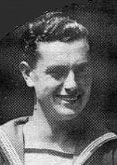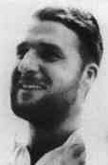 |
 |
|
Able Seaman
Colin Grazier, G.C. |
Lieutenant
Anthony Fasson, G.C. |
 |
 |
|
Able Seaman
Colin Grazier, G.C. |
Lieutenant
Anthony Fasson, G.C. |
On 1st February 1942 the German Navy introduced M4, a version of the Enigma with a rotatable Umkehrwalze and a set of eight rotors, three of which were fitted in the Enigma at any one time. The effect of M4 was to immediately lock Bletchley Park out of SHARK, the Atlantic and Mediterranean U-boat traffic.
Later that year, on 30th October off Port Said, four Royal Navy destroyers, one of which was HMS Petard, obtained ASDIC contact with a U-boat. After a sustained depth charge attack lasting about ten hours the U-boat was finally forced to the surface at about 22.40. Petard's searchlights stabbed through the night and picked out the U-boat's conning tower which had a white donkey emblem and the numerals U-559 painted on it. The conning tower was soon struck by a shell from one of Petard's 4" guns causing the U-boat's crew to abandon ship. Petard's first officer, Lieutenant Anthony Fasson, a likable, respected and efficient officer, dived into the sea followed by Able Seaman Colin Grazier and Tommy Brown, a 16 year old canteen assistant who had lied about this age to join the Royal Navy. The trio swam to the stricken U-boat and climbed down inside the conning tower to find the lights still on.
In the captain's cabin Fasson found some documents printed in water-soluble ink. Despite the water pouring through the shell hole, Brown succeeded in keeping them dry as he clambered up the ladder in the conning tower and passed them to others waiting in Petard's whaler made fast alongside. Brown twice reentered the U-boat, each time returning with more documents.
Fasson returned to the control room to wrench a radio or radar set from its fixings but by this time the water inside the U-boat was knee-deep and rising. Brown, now on top of the conning tower, shouted 'You had better come up!' down into the U-boat as its afterdeck was well underwater. As Grazier and Fasson started up the ladder, the U-boat suddenly sank. Brown jumped clear, but U-559 made her last dive taking Fasson and Grazier with her.
The documents retrieved from U-559 reached Bletchley Park on November 24th. They proved to be the Wetterkurzschlussel and Kurzsignalheft, which yielded a priceless set of cribs. On December 13th, a crib obtained using the Wetterkurzschlussel gave a key with M4's rotatable Umkehrwalze in the neutral position, making it equivalent to a standard Enigma and thus potentially breakable on existing bombes. Six bombes were plugged-up accordingly and run. Later that afternoon, after a blackout of ten months, the naval section at Bletchley Park telephoned the Admiralty's Operational Intelligence Centre to report the break into SHARK. Within the next hour the first intercept chattered off the teleprinter indicating the position of more than a dozen U-boats. A stream of intercepts followed allowing the rerouting of convoys around the waiting wolfpacks. Allied shipping losses in the Atlantic were consequently halved in January and February 1943 and, perhaps even more vitally, procedures were developed which facilitated the breaking of SHARK for much of the remainder of the war. Fasson, Grazier and Brown's action consequently saved millions of tons of Allied shipping and tens of thousands of Allied lives. As eminent naval historian Ralph Erskine has put it: 'Few acts of courage by three individuals can ever have had so far-reaching consequences.'
Ineligible for the Victoria Cross since the action did not take place under enemy fire, Fasson and Grazier were each posthumously awarded the George Cross. Brown, who survived, was awarded the George Medal but died in 1945 attempting to rescue his sister from a house fire.
There are accounts of this action in Capturing Enigma: How HMS Petard Seized the German Naval Codes by Stephen Harper and Seizing the Enigma: The Race to Break the German U-boat Codes 1939-1943 by David Kahn.
Despite this and the memorial sculpture to the three in Grazier's hometown of Tamworth in Staffordshire; Fasson, Grazier and Brown's action has never received the widespread public recognition which it deserves.
Copyright © Graham Ellsbury 1998
Return to The Enigma and the Bombe main page